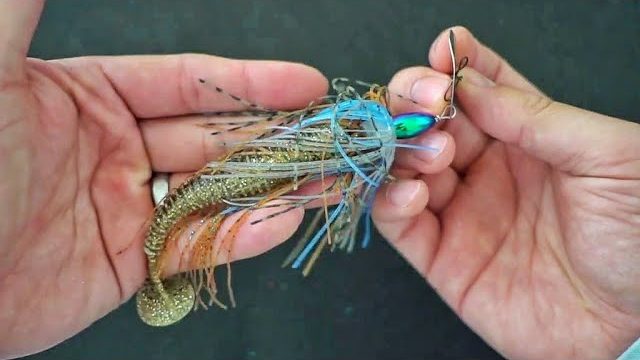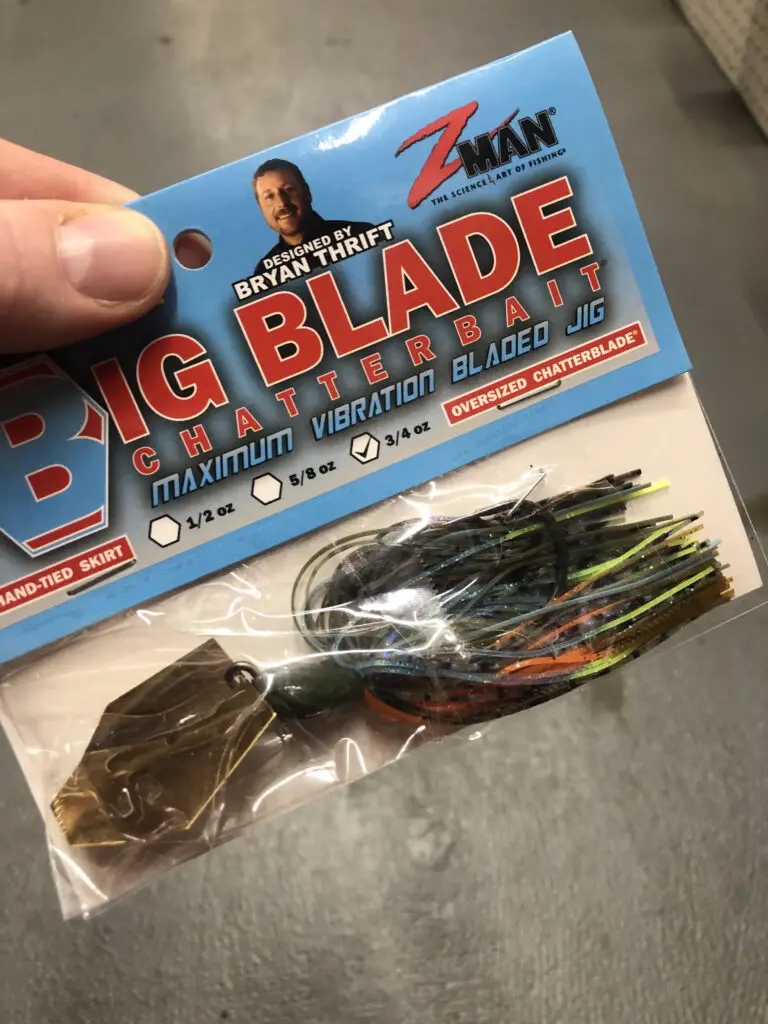A chatterbait lure is a bladed swim jig, combining a jig head, skirt, and hexagonal metal blade. The blade creates vibration and flash during retrieval, mimicking baitfish and attracting predatory fish like bass. Chatterbaits are versatile and can be fished at various depths and speeds, often paired with a soft plastic trailer.
The chatterbait is one of the most unique lures that has emerged in the last few decades. It incorporates various elements of other very popular lures into one of the most effective and innovative designs in the industry.
Table of Contents
History of the Chatterbait Lure
The chatterbait is the invention of professional angler and luremaker Ron Davis. During the spring of 2003, Ron and his father had been discussing and trying various new ways to enhance their similar spinnerbaits and lures. Noting the similarities between the jig and a spinnerbait, it was easy to see how they might combine into a formidable bass-catching contraption.
After testing various designs, Ron and his father finally settled on pairing a skirted jig with a six-headed blade instead of the usual one or two blades that most spinnerbaits had. The results were instantly noticeable. The lure had a very intense vibration and fish seemed to attack it much more often than the other lures the two men had designed.
Noting the success of what they had discovered, Ron’s father made the witty remark that the lure’s extreme vibration is enough to make the angler’s teeth chatter. With that simple joke, the name ‘chatterbait’ was born.

The lure would break out onto the professional bass fishing scene just a few years late in 2006 when Bryan Thrift, a little-known angler at the time, managed to weigh in a massive 39 lb 9 ounce bag on a 10-fish limit to take home the title at a pro tournament on Florida’s Lake Okeechobee.
Almost all the other anglers turned in meager bags at the tournament, prompting everyone to ask how he caught so many sizable bass. Thrift attested that the chatterbait was the main lure that made the difference. Since then, the lure has undergone a few specific alterations and has become a staple among top anglers’ tackle arsenals.

How Does a Chatterbait Work
The chatterbait is a relatively simple design that you might compare to a single-bladed spinnerbait. It has a jig body with a head that closely resembles that found on a spinnerbait as it is made to be steadily retrieved through the water if the angler chooses to. The chatterbait also has a skirt around the ‘body’ portion designed chiefly to hide the hook and help the lure appear as if it is swimming while it’s being retrieved through the water.
Instead of the six-sided blade being connected by a wire like a spinnerbait, the distinct blade is fitted onto a loop that’s part of the jig-head. The angler’s line connects to a small wire which runs through the middle of the six-sided blade near the upper side.
The blade’s very distinct shape is a result of years of testing and research done by Davis and other fishing lure designers and companies throughout the years. Its shape and how the angler’s line connects to the middle of the blade allows it to give off a very hard-hitting ‘thump’ motion as it delivers much greater vibration when retrieved than any other bladed lure.
The chatterbait is sometimes called a bladed swim jig, bladed jig or a variety of other names, but anglers mostly call it by its original name—the chatterbait.

Chatterbait vs Spinnerbait Lures
Much is to be said about the debate between a chatterbait vs spinnerbait and which lure is best for specific applications. Here, we will mainly note the significant differences and how the chatterbait has certain advantages that the spinnerbait doesn’t offer. If you were to ask any professional angler, the chatterbait is an outstanding lure, but it still doesn’t unseat the classic spinnerbait.
As we mentioned above, a spinnerbait’s design relies on a single wire that holds together both the ‘jig’ portion of the lure and the blade or blades. The angler’s line is tied to a small lip in the middle of this wire and a spinnerbait can be greatly damaged and even rendered completely useless if it incurs a violent strike that breaks or significantly bends this wire.
A chatterbait, on the other hand, connects to your line using a very small wire that is usually less than an inch in length. This wire connects to the six-sided blade of the chatterbait first and it is the blade that is then connected to the chatterbait’s jig nose loop. This design difference might seem insignificant to some anglers, but it’s a true game-changer for those who understand what makes both types of lures effective.
The central placement of this six-sided blade gives the chatterbait a vibration that pulsates outward from the bait itself. The offset placement of a spinnerbait’s blades is done so that the lure’s ‘body’ doesn’t interfere with the output of this vibration. The spinnerbait’s blades wouldn’t function if they were connected to the lure in the same fashion as the chatterbait.
The spinnerbait and the chatterbait have their own strengths and weaknesses, but we will likely cover that in another article.
Chatterbait vs Swim Jig Lures
The chatterbait and the swim jig are two very similar lures when you consider the body of each one. In most cases, the jig’s head, skirt and hook are virtually identical to that of the chatterbait. A swim jig might often appear to be a chatterbait without it’s characteristic ‘six-sided’ blade attached.
Both of these lures can be used in any depth scenario, from deep to shallow, but the main difference lies in low visibility. A chatterbait is a lure that truly shines in muddy or murky waters with very low visibility because of its intense vibration. Fish will often strike at a chatterbait without getting a decent look at it simply because the vibration it puts off is very similar to most bait fish.
A swim jig excels in clear conditions when bass can see their prey and they are not relying on their sense of feel to detect their next meal. This doesn’t mean that a chatterbait won’t work in clear water, but that you can have more of a finesse approach with a swim jig when fishing in water with greater visibility.

Chatterbait vs Crankbait Lures
Many anglers new to the chatterbait might point to the fact that the lure has quite a few things in common with a typical crankbait. This is somewhat of an accurate assessment, but some stark differences should be noted between a crankbait vs chatterbait. A chatterbait can usually have very similar effects and results that you might get from a crankbait, but there are times when one might be a better choice than the other.
I prefer a chatterbait when I’m trying to cover a lot of water and make very long casts. I especially like to do this during the early spring when bass are moving up into the shallows from the deep waters in preparation to begin their annual spawning ritual. Where a chatterbait comes in handy is when I want to be able to fish anywhere in the water column that I want without having to swap out lures. A crankbait won’t allow me to let the bait sink like a chatterbait does before retrieval.
A crankbait is a better choice when you have a firm grasp of the fish’s depth and want a lure that will remain at that specific part of the water column throughout your retrieve. Having the right crankbait allows you to accomplish this as you can choose between a lipless, shallow diving, medium or deep diving crankbait to hit any part of the water column where you want to target bass.
A lot more could be said about the debate between a chatterbait vs crankbait, but I will summarize with the following statement. I like to use a chatterbait when I’m fishing with a ‘searching’ strategy and I’ll specifically use a crankbait when I’m fishing with a ‘targeted’ approach in which I’m already aware of the bass’ location and depth.
Conclusion
There are plenty of other points that we can get into and we cover them in our article on how to fish a chatterbait. This new lure has gained popularity for good reason as many professional anglers have realized over the years that the chatterbait is an incredibly versatile lure that opens up seemingly endless possibilities. If you don’t already have this lure in your fishing arsenal, it’s one that you should think about adding sooner rather than later.

